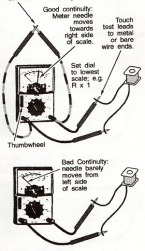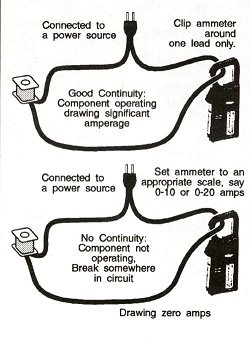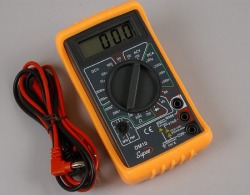
Custom Search
Using a Multimeter to test electrical appliances
Appliances are electro-mechanical devices-- that's a fancy word that means they have electrical and mechanical parts. This also means that appliances can have either electrical or mechanical failures. Most people with one eye and half a brain in their skull can figure out the mechanical part. But very few do-it-yourselfers have even the basic skills needed to troubleshoot an electrical problem in an appliance such as reading a schematic and wiring diagram and using an inexpensive multimeter like the one shown here above ($15), to make electrical measurements.
Using a Multimeter to Measure Continuity or Resistance

The picture to the left shows how to measure resistance. Resistance is measured in units called "ohms." You'll commonly want to know the resistance of things like bake elements and solenoid coils. For example, a good bake element typically has a resistance of about 30 ohms. If your oven's not baking and you measure the resistance of the bake element and the meter doesn't move, then you know you'got a bad element.
A special type of resistance measurement that we commonly make in the field is a continuity measurement. When we're testing continuity, we don't care what the actual resistance is, we just want to know if the thing being tested (switch, wire, fuse, etc.) will allow electricity to flow through it. Continuity is a "yay" or "nay" measurement, a component either has continuity or it doesn't.
Two things to remember when making resistance measurements: 1) the circuit should be de-energized. 2) remove at least one wire attached to the component you're testing to disconnect it from the rest of the circuit so you're not getting a false reading by measuring through the rest of the circuit.
A special type of resistance measurement that we commonly make in the field is a continuity measurement. When we're testing continuity, we don't care what the actual resistance is, we just want to know if the thing being tested (switch, wire, fuse, etc.) will allow electricity to flow through it. Continuity is a "yay" or "nay" measurement, a component either has continuity or it doesn't.
Two things to remember when making resistance measurements: 1) the circuit should be de-energized. 2) remove at least one wire attached to the component you're testing to disconnect it from the rest of the circuit so you're not getting a false reading by measuring through the rest of the circuit.
Voltage Measurements

The picture to the left shows how to measure voltage. A voltage measurement at the outlet should be the first thing you do whenever you have an appliance that is completely inoperative, or if you have an electric dryer that's not heating, or an electric range that doesn't get hot enough. You'll need to know the basic anatomy of these various electrical outlets to know what to measure for.
Obviously, to measure voltage, there must be power present. This means you can have a hair-raising experience if you touch the wrong thing with your bare hands. As long as you're holding the probes by the insulated handles and are careful about where you place the metal points of the probes, you'll be fine. I've been working with electricity for over 30 years and I still get shocked every now and then. It only hurts a little, kinda like a snake bite, and it fades quickly. So don't freak out.
Besides the outlets, you'll frequently need to measure voltage at various points inside the appliance. Usually, you're measuring this voltage with respect to ground. That just means that you can clamp one probe to an unpainted metal place on the appliance chassis and then touch the other probe to the points of interest. Your other hand should either be tucked in your pocket or behind your back. This way, you won't get shocked because you won't be giving the current a path to flow through your body. Easy, da?
Obviously, to measure voltage, there must be power present. This means you can have a hair-raising experience if you touch the wrong thing with your bare hands. As long as you're holding the probes by the insulated handles and are careful about where you place the metal points of the probes, you'll be fine. I've been working with electricity for over 30 years and I still get shocked every now and then. It only hurts a little, kinda like a snake bite, and it fades quickly. So don't freak out.
Besides the outlets, you'll frequently need to measure voltage at various points inside the appliance. Usually, you're measuring this voltage with respect to ground. That just means that you can clamp one probe to an unpainted metal place on the appliance chassis and then touch the other probe to the points of interest. Your other hand should either be tucked in your pocket or behind your back. This way, you won't get shocked because you won't be giving the current a path to flow through your body. Easy, da?
Current Measurement

Here's a clamp-on ampmeter (or amp meter) being used to measure current flow through a wire.

